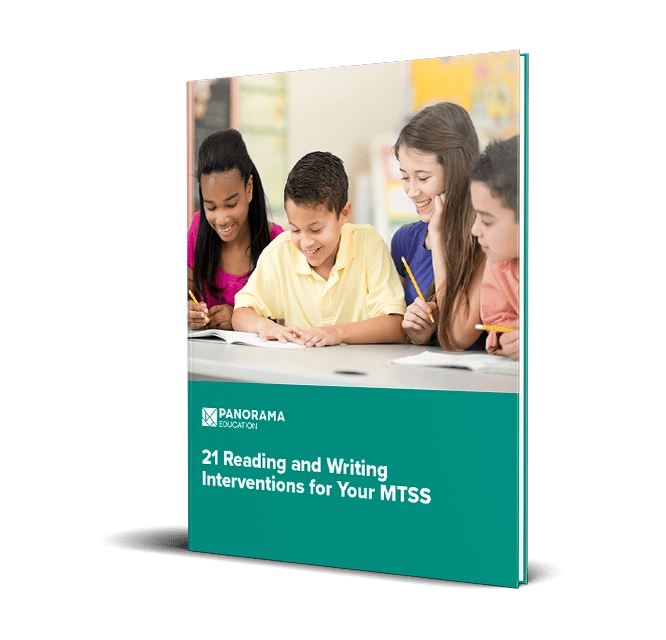Updated January 31, 2024
***
Reading well by third grade is a key benchmark for students. Research shows that students who aren’t proficient in reading by the end of third grade are four times more likely to drop out of high school than proficient readers. Third grade is the final year that students are learning to read, rather than reading to learn across different academic disciplines.
If you're building a district improvement plan around literacy, you know that system improvement will mean more than revamping literacy instruction or implementing a few new teaching strategies. It requires a rich toolbox of strategies to:
- Build educator capacity
- Effectively use data
- Deliver the right interventions at the right time for rising readers
- Communicate with families
We analyzed literacy plans from districts nationwide to bring you this list of 18 effective strategies. We hope you'll use these ideas for inspiration as you build or evaluate your own literacy action plan.
|
Key Takeaways: Holistic Approach to Literacy Improvement:
Emphasis on Evidence-Based Practices
Family and Community Engagement:
|
18 Strategies for Improving 3rd-Grade Literacy in Your District
1. Establish and communicate specific goals around literacy.
Each district will have different goals around literacy and reading. Maybe your goal is to have a certain percentage of students reaching reading proficiency by grade three. By establishing and communicating goals, it's easier for your district to measure against these benchmarks. Additionally, clear goals make the work meaningful for educators on the ground!
2. Develop or identify a reading curriculum that is aligned to rigorous and clearly defined standards.
Your curriculum should take a multifaceted approach to literacy that includes phonics and reading comprehension. Curriculum aligned to and informed by the Science of Reading helps students develop key ELA skills. Consider downloading Panorama's free Science of Reading Toolkit to establish strong literacy foundations in your district's MTSS.
3. Don’t just set literacy goals and leave schools to execute on their own.
Provide them with systems, tools, reading strategies, ongoing support, and check-in points. In other words, invest resources and time behind the literacy goals that you say are important.
4. Build cross-functional momentum and collective ownership around your goals through a District Literacy Leadership team.
Too often, literacy work is siloed. A team of school and district leaders, teachers, and community partners can convene annually or bi-annually to reflect on progress and revise or adjust action steps as necessary.
5. Leverage literacy coaching across the district to ensure that all educators understand and can apply the components of literacy instruction to lesson plans.
Literacy coaches can also be made available for individual teacher coaching, modeling of reading instruction, and collaboration.
6. Invest in professional development that builds educator capacity around the Science of Reading.
Ensure all educators understand the fundamentals of how our brains learn to read. Ongoing professional development supports teachers as they deepen their understanding of Science of Reading principles. And strengthening systems of support helps educators apply them to literacy instruction.
7. Focus on life skills and school climate to create a positive and safe environment where students feel ready to read and learn.
When students develop stronger life skills—such as self-efficacy and growth mindset—they are better prepared for academic learning. Life skills can also develop readers by teaching them:
- Critical thinking
- Learning strategies
- Skills for collaborating with their peers around reading
8. Require universal screening for students in grades K-3 to support early identification of struggling readers.
Universal screening for younger students can help educators catch and diagnose reading problems during the years that matter most.
9. Develop a shared language across schools by using common “statuses” for students receiving tiered reading supports.
This shared language ensures all educators understand how students are progressing through interventions. For example, your literacy statuses for readers might be “Behind,” “At Risk,” “Progressing,” and “On Track" within a Multi-Tiered System of Supports (MTSS) or Response to Intervention (RTI) framework.
10. Ensure that schools are creating and nurturing a culture of literacy.
Provide them with creative ideas for Tier 1, universal supports that all students receive across content areas. Incorporating consistent literacy strategies for reading helps students engage consistently with reading and writing skills. Examples include:
- Sending weekly reading progress updates
- Visually tracking students’ reading levels in the classroom
- Hosting book fairs
- Having a book of the month
- Holding reading challenges.
11. Ensure that schools are making reading accessible and engaging to students from diverse backgrounds.
Are students exposed to content-area stories and texts about people who look like them and/or come from similar backgrounds as they do? This is key as students engage with texts, and helps to build strong classroom communities, and life skills such as social awareness.
12. Establish a set of recommended, evidence-based Tier 2 and Tier 3 literacy interventions across schools.
Tier 2 interventions could include small group pull-outs for targeted reading instruction. Tier 3 interventions (for students persistently at risk) could include intensive, individualized 90-minute daily sessions for teaching reading. Ensure that all staff are trained to implement interventions with fidelity.
13. Require data-driven, weekly progress monitoring for students who are at risk in reading and receiving intervention.
These checkpoints are opportunities to measure growth towards the goal and whether or not interventions are meeting student needs. If you're looking for additional support, download our free Interventions and Progress Monitoring Toolkit. Feel free to share this toolkit with teachers and student support teams.
14. Encourage schools to create cross-functional PLCs or Student Support Teams (SSTs) that meet monthly or on a regular basis to monitor student progress and collaborate on interventions.
For example, Utah’s Ogden School District uses Child Assistance Teams (ChATs) in every school. These teams mobilize around at-risk students and deliver Tier 2 supports. Build or support your teams with Panorama's free MTSS Team Toolkit.
15. Centralize literacy interventions and progress monitoring by using a MTSS software platform.
This can save time for staff and streamline data protocols so that educators can focus on supporting students instead of compiling data. It can also strengthen cross-team collaboration and accountability toward literacy goals.
16. Provide schools with a list of ideas, reading strategies, and resources for equipping parents to support literacy improvement at home.
Encouraging students to practice literacy skills at home can help create lifelong readers. Consider:
- Providing parents with materials to practice reading skills with their child
- Making YouTube videos to read aloud phonic sounds
- Sending home laminated bookmarks with question prompts for parents to use with their child
17. Establish firm guidelines for schools regarding communication with parents and families about literacy intervention.
Communication is another key component in strengthening family-school relationships and supporting students' literacy development. Your district should determine what communication looks like, and what data should be included. Additionally, identify a predictable schedule for updating families on student progress.
18. Run family feedback surveys to better understand the confidence level of families when it comes to supporting reading at home.
The data can help you identify where families may need more support. For example, after Wake County Public Schools (NC) collected survey feedback from families, one elementary school took action on the data by hosting a literacy-themed family teacher night.
|
Frequently Asked Questions: 1. How can our district establish effective literacy goals? 2. What should we consider when selecting a reading curriculum? 3. How can we ensure our literacy initiatives are effectively implemented in schools? 4. What strategies can we use to support struggling readers effectively? 5. How can we engage families to support literacy improvement at home? |
Next Steps for District Leaders
By investing in early literacy skills, district leaders can take concrete steps to support students’ reading and writing journeys. A platform like Panorama Student Success can support school and district leaders as they build firm literacy foundations within their MTSS. In fact, Student Success is proven to improve reading scores, meeting the Every Student Succeeds Acts (ESSA) standards for Level 2 and 4.







